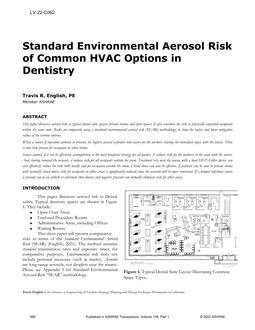
LV-22-C062 – Standard Environmental Aerosol Risk of Common HVAC Options in Dentistry
- Comments Off on LV-22-C062 – Standard Environmental Aerosol Risk of Common HVAC Options in Dentistry
- ASHRAE
This paper discusses aerosol risk in typical dental suite spaces: private rooms, and open spaces. It also considers the risk to physically separated occupantswithin the same suite. Risks are compared, using a standard environmental aerosol risk (SEAR) methodology, to show the higher and lower mitigationvalues of the various options.
When a source of infectious aerosols in present, the highest aerosol exposure risk occurs for the workers sharing the immediate space with the source. Thereis also risk present for occupants in other rooms.
Source control, if it can be effectively accomplished, is the most beneficial strategy for all parties. It reduces risk for the workers in the room with the source.And, having removed the aerosols, it reduces risk for all occupants outside the room. Treatment very near the source, with a local HEPA filter device, canalso effectively reduce the risk both locally and for occupants outside the room. Closed doors can also be effective. If patients can be seen in private roomswith normally closed doors, risk for occupants in other areas is significantly reduced, since the aerosols will be more contained. If a known infectious sourceis present, use of an airlock or anteroom (two doors), and negative pressure can virtually eliminate risk for other areas.
Product Details
- Published:
- 2022
- Number of Pages:
- 7
- Units of Measure:
- Dual
- File Size:
- 1 file , 1.5 MB
- Product Code(s):
- D-LV-22-C062
- Note:
- This product is unavailable in Russia, Belarus
Post navigation
Related Posts

Seminar 17 — How to Select and Size HVAC Fans for Optimum Acoustical Performance
- Comments Off on Seminar 17 — How to Select and Size HVAC Fans for Optimum Acoustical Performance

040 — Real-Time Occupancy Detection in Hospital Patient Rooms Using Sensor Fusion
- Comments Off on 040 — Real-Time Occupancy Detection in Hospital Patient Rooms Using Sensor Fusion

Seminar 25 — Fundamentals of Division 25: Integrated Controls and Cyber Security
- Comments Off on Seminar 25 — Fundamentals of Division 25: Integrated Controls and Cyber Security
